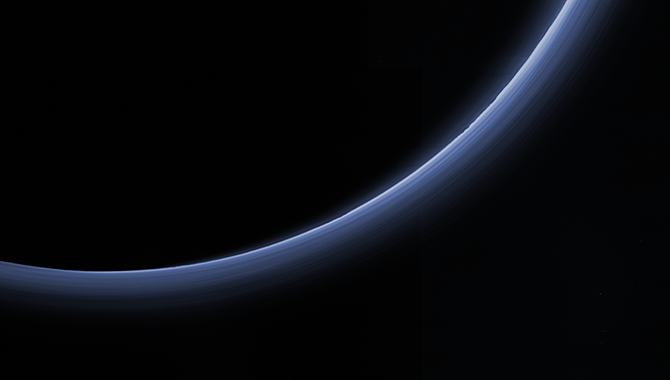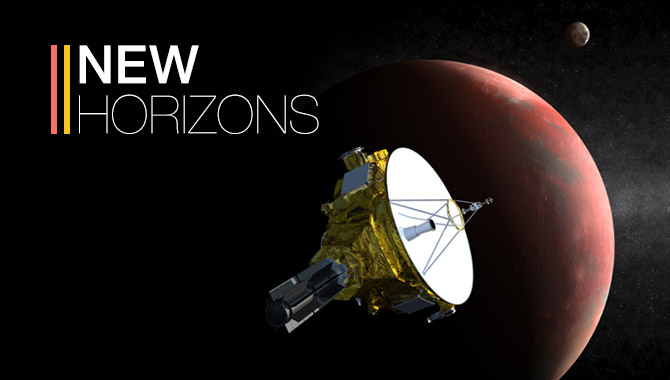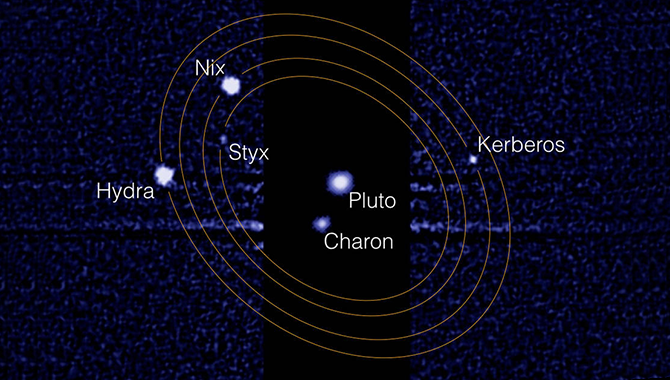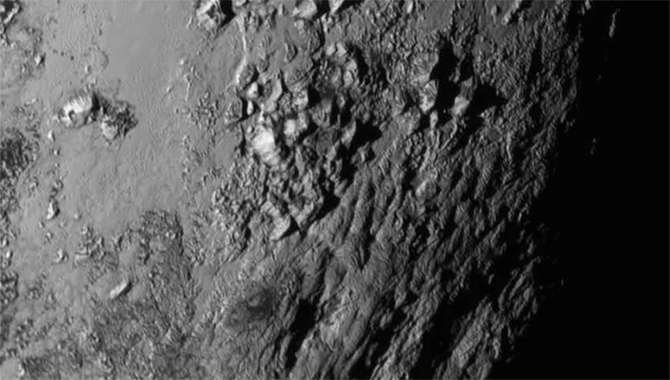
The haze layers in Pluto’s atmosphere are visible in this picture constructed from a combination of four panchromatic images taken by New Horizons’ Long Range Reconnaissance Imager (LORRI), adjusted with four-color filter data from the spacecraft’s Ralph/Multispectral Visible Imaging Camera (MVIC). The photographs were taken during the flyby on July 14, 2015.
Photo Credit: NASA/JHUAPL/SwRI
Ten years ago this month, NASA’s New Horizons became the fastest spacecraft ever launched—after a critical hardware concern almost left it stranded on the launch pad.
Pluto, initially considered the ninth planet in the solar system, was discovered in 1930. Sixty years later, telescopic capabilities advanced sufficiently to reveal that it wasn’t a planet at all: it was an “icy dwarf,” part of the previously unknown third zone of the solar system. Objects in this zone, called the Kuiper Belt, are remnants of the formation of the solar system. Scientists avidly wanted to learn more about them, as they could offer unparalleled information about the development of Earth and other planets.
In 2002, a mission to Pluto was formed: New Horizons. The team designed, built, and tested a piano-sized spacecraft that would carry seven scientific instruments to record the first-ever flyby of a Kuiper Belt object. From a design perspective, creating the spacecraft wasn’t the only challenge; crafting a mission profile that would minimize time spent on the lengthy journey to Pluto was crucial as well. Even at their closest, Pluto and Earth are separated by over two and a half billion miles and a minimum of nine long years of space travel. When they are farthest apart, that distance nearly doubles.
The New Horizons team planned to condense the journey by taking advantage of a 17-day launch window between January 11 and January 27, 2006. Liftoff during this period would put the spacecraft on the shortest trajectory to Pluto while leveraging a gravity assist from Jupiter for a boost of speed halfway through the trip. The timing was critical: if the spacecraft missed this time frame, the situation became increasingly dire. Launching between January 28 and February 2 would increase the journey by a year or two. Launching as late as February 14 would force the spacecraft to miss the gravity assist from Jupiter and prolong the journey another few years. After February 14, the launch would have to be postponed entirely until 2007. Each delay increased the cost and risk for the mission.
The launch window wasn’t the only element in New Horizons’ plan to minimize the duration of the spacecraft’s journey to Pluto. Another vital component was the launch vehicle. In order to achieve the record-breaking velocity needed for its flight plan, New Horizons required a rocket with an enormous amount of thrust. They chose the Atlas V: a powerful new iteration in the trusted Atlas family of rockets. Atlas V had already been part of seven successful launches, but New Horizons needed a novel configuration that included five solid rocket boosters (SRBs) to provide the necessary speed. This would be the first time the Atlas V had flown with more than three SRBs. As a result, it had to complete a series of re-qualification tests.
Those tests came to an abrupt halt in September 2005 when the Atlas V Rocket Propellant 1 (RP-1) tank failed catastrophically. Multiple organizations—including Lockheed Martin, who built the Atlas V, NASA’s Launch Services Program (LSP) at Kennedy Space Center (KSC), and Safety & Mission Assurance (SMA)—rushed to determine the cause of the failure. Photographs of the failed fuel tank provided an important clue. Looking at images taken before re-qualification testing had even started, LSP engineers noticed a visible crack in the tank. The tank design had been altered as the Atlas V evolved, and it appeared that a modification to the area around the tubular liquid oxygen feed link had caused cracks in some of the tanks. Later investigation revealed cracks or corrosion in five of the seven existing R-1 tanks built for the Atlas V. Clearly, the design was flawed.
This stopped New Horizons cold. Months of further analysis and testing would be needed before a fully qualified tank—one that could meet the unique need of the New Horizons mission for extra power at launch—would be ready. They would miss their crucial launch window.
The team wasn’t ready to give up. They decided to examine the interior of the fuel tank on New Horizons’ launch vehicle, which was already on the launch pad. After reviewing detailed video and still images of the tank’s interior, they learned that the fuel tank on their Atlas V did not contain a single crack. It was in perfect condition for flight. This left them with an unprecedented dilemma: could the mission proceed with a fuel tank that appeared flight ready—but wasn’t qualified to meet the mission’s needs?
On the surface, the answer was no. NASA process called for re-qualification tests given the unique configuration of the mission’s launch vehicle, and those tests had not been completed. The team lacked the needed engineering analysis validation to prove the fuel tank could withstand the pressures of launch. The risk to the mission was too great.
That wasn’t the only problem. If the tank failed during early ascent, a second risk emerged: radiation. Because the spacecraft would travel too far from the sun to rely on solar energy, the electrical power on New Horizons was provided by a radioisotope thermoelectric generator (RTG), which ran on plutonium. RTGs were commonly used and had powered such missions as Apollo, Viking, and Voyager. But could New Horizons risk a launch with an unproven fuel tank when nuclear power was involved? What if the rocket failed in early ascent and the RTG was destroyed, sending radiation into Earth’s atmosphere? From a practical perspective, the risk of that occurring was extremely low; and the amount of plutonium suggested the risk to humans, if it did occur, was negligible. From a PR perspective, however, it could be a disaster.
The New Horizons team and LSP continued to search for a path to a 2006 launch. For many reasons, they believed the launch should go forward. First, the flight tank was flawless. It didn’t exhibit any of the cracks that had been present on the test tank even before testing began. Second, the test tank had nearly completed the full battery of re-qualification tests before failing—even though it was cracked throughout the process. This suggested the clean tank would have plenty of margin to perform as needed. Third, KSC’s LSP had changed New Horizons’ mission profile to relax the pressure on the fuel tank and minimize the danger of radiation release over land in the event of a launch failure. Finally, extending the launch date into the future would mean the spacecraft would face a longer trajectory and would lack a gravity assist from Jupiter. This would expand the duration of the journey to 15 years, increasing both risk and cost.
By December 14, 2005, no decision had been made. The launch was pushed back to January 17, 2006. On January 3, the team conducted a second examination of the tank’s interior: once again, no cracks were found. A week later, the Flight Planning Board (FPB) convened to make a final decision on whether the launch could proceed in 2006. An advocate of launching as planned, FPB chairman Bill Gerstenmaier—then-Associate Administrator for Space Operations at NASA headquarters—requested the presence of NASA Administrator Dr. Michael Griffin. In the end, with a deadlock between the serious concerns of SMA and NASA Engineering & Safety Center (NESC) and the perspective of LSP, which believed New Horizons could fly safely, the decision came down to Griffin. He determined that LSP had applied good engineering judgment: the risk from the RP-1 tank was understood and acceptable, and New Horizons could proceed.
On January 19, 2006—after two days of delays unrelated to the tank—New Horizons left Cape Canaveral on its Atlas V. Liftoff proceeded as planned. It quickly made history as the fastest spacecraft ever launched from Earth, immediately entering a solar system escape velocity of 36,000 miles per hour.
This was not the only historic moment for the mission. Nine and a half years later, after traveling more than three billion miles through space, New Horizons brought the world its first close-up view of Pluto on July 14, 2015. It became the first mission to examine a binary planet, the first to explore a Kuiper Belt object, and the first to penetrate the mysterious third zone of the solar system.
When New Horizons emerged safely after its flyby, Alan Stern, New Horizons Principal Investigator at Southwest Research Institute (SwRI) in Boulder, Colorado, said, “Following in the footsteps of legendary projects by NASA called Mariner, Pioneer, and Voyager, New Horizons has succeeded at completing the capstone to the historic first era of planetary reconnaissance.”
The mission, like the launch, had overcome obstacles to bring the world something it had not experienced since Voyager flew past Jupiter and Saturn: the opportunity to see a new world for the first time.
“Nothing like this has been done in a quarter century,” said Stern, “and nothing like this is planned by any space agency ever again.”
Download an APPEL case study about Launching New Horizons: The RP-1 Tank Decision.
Read an APPEL News article about New Horizons’ historic encounter with Pluto.









